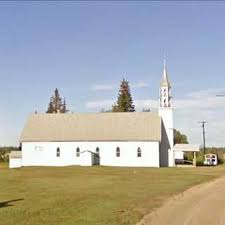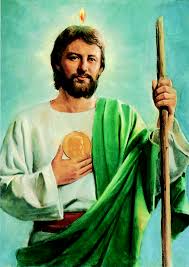|
St. Jude - Our Patron Saint
St. Jude is often referred to as the Patron Saint of Hope and impossible causes and is believed to be one of Jesus's original twelve Apostles. He preached the Gospel with great passion, often in the most difficult circumstances. Through the power of the Holy Spirit, he made profound differences in people's lives as he offered them the Word of God. The Gospel tells us that St. Jude was a brother of St. James the Less, also one of the Apostles. They are described in the Gospel of Matthew as the "brethren" of Jesus, probably cousins. St. Jude is often confused with Judas Iscariot who betrayed Jesus. After the death and resurrection of Jesus, St. Jude traveled throughout Mesopotamia, Libya and Persia with St. Simon preaching and building up the foundations of the early Church. St. Jude died a martyr's death for his unwavering faith. His body was later brought to Rome and placed in a crypt under St. Peter's Basilica. Some background information about images of St. Jude: Why is St. Jude holding a medallion? The medallion is an impression of Jesus, known as “The Image of Edessa.” King Abgar of Edessa (now part of Turkey) was suffering from a serious illness. He had heard of Jesus healing others and called for Jesus to heal him. Jesus pressed His face onto a piece of cloth and gave it to St. Jude to present to King Abgar. Upon receiving the cloth King Abgar was healed. This scene is depicted in one of the stained glass windows at Our Lady of Guadalupe Church, where the National Shrine of St. Jude is located. Why is there a flame above St. Jude's head? Known as “The Tongue of Flame,” this represents the Holy Spirit descending upon St. Jude and the other Apostles at Pentecost. “They saw what seemed to be tongues of fire that separated and came to rest on each of them. All of them were filled with the Holy Spirit and began to speak in other tongues as the Spirit enabled them” (Acts 2:3-4). Why does St. Jude wear green? St. Jude is depicted wearing green because green symbolizes hope and renewal. Just as in spring when foliage and flowers spring up with renewed life, we turn to St. Jude, our Patron of Hope, in difficult or seemingly hopeless times. What is St. Jude's relationship with Jesus? There are differing views on exactly how St. Jude is related to Jesus. Some writings identify St. Jude as “Judas the brother of James,” while others refer to him as “Judas the son of James.” Galatians 1:19 tells us that James is a brother of Jesus. However, in the Gospel of Matthew 13:55, St. Jude is said to be a brother of Jesus. “Isn’t this the carpenter’s son? Isn’t His mother’s name Mary, and aren’t His brothers James, Joseph, Simon, and Judas?” Regardless, we know that St. Jude was one of Jesus’ Apostles and that they shared a close relationship. Where is St. Jude located in da Vinci's Last Supper? Located second from the right, St. Jude Thaddeus is shown with a beard and long, light colored hair. He is sitting between St. Simon (far right) and St. Matthew (third from the right). How did St. Jude die? St. Jude was martyred in 65 AD with St. Simon in Persia on October 28 (their feast days). There are differing accounts regarding how St. Jude died. Some say he was beaten to death and beheaded, or hacked to death, which is why he is often depicted with a club or axe. St. Jude’s remains are located in St. Peter’s Basilica in Rome. How did devotion to St. Jude begin? After his death, many turned to St. Jude for his intercession in prayer. Jesus inspired the devotion to St. Jude for St. Bridget of Sweden when He directed her in a vision to turn to St. Jude with great faith and confidence. In a vision, Christ told St. Bridget, “In accordance with his surname, Thaddeus, the amiable or loving, he will show himself most willing to give help.” During the Middle Ages, St. Jude was widely venerated, but perhaps because of the confusion between his name and that of Judas Iscariot, he slipped into temporary obscurity. In the early 20th century, St. Jude Thaddeus was relatively unknown to the general Catholic population in the United States. In 1929, the first devotional services to St. Jude were held by Claretian Fr. James Tort at Our Lady of Guadalupe Church in southeast Chicago; before the year ended, the country’s only National Shrine of St. Jude would be firmly established. Word of the devotions to St. Jude gradually spread from that tiny corner of Chicago to other parts of the country. During the Great Depression and World War II, thousands of men, women, and children attended novenas at the Shrine; devotion to the “patron saint of hopeless causes” spread throughout the country. The above excerpts are taken from: shrineofstjude.org/the-shrine/st-jude/# |
Our Church in Green Lake is open. Please exercise caution to keep people safe!
If you need to contact Fr. Doug please call the Parish Office at (306) 236 5122 or you can call or text (306) 304 7271! Notice that there is a flame over the head of St. Jude - depicts the descent of the Spirit; he is dressed in green - a sign of hope; the medallion on his chest depicts the face of Christ and the staff in his hand is symbolic of the way he died.
A Prayer to St. Jude
(Taken from the Dominican Shrine of St. Jude) Most holy Apostle, Saint Jude Thaddeus, friend of Jesus, I place myself in your care at this difficult time. Help me know that I need not face my troubles alone. Please join me in my need, asking God to send me: consolation in my sorrow, courage in my fear, and healing in the midst of my suffering. Ask our loving Lord to fill me with the grace to accept whatever may lie ahead for me and my loved ones, and to strengthen my faith in God's healing powers. Thank you, Saint Jude Thaddeus, for the promise of hope you hold out to all who believe, and inspire me to give this gift of hope to others as it has been given to me. V. Saint Jude, Apostle of Hope R. Pray for us! St. Leo once said “Prayer has the greatest efficacy to obtain favors from God when it is supported by works of mercy.” Don’t forget to help someone in need as part of your prayer to St. Jude. SOME SITES FOR ACCURATE
COVID-19 INFORMATION: Saskatchewan Health Authority - https://www.saskatchewan.ca/government/health-care-administration-and-provider-resources/treatment-procedures-and-guidelines/emerging-public-health-issues/2019-novel-coronavirus; Canada’s Public Health - https://www.canada.ca/en/public-health/services/diseases/2019-novel-coronavirus-infection.html; World Health Organization - https://www.who.int) |

